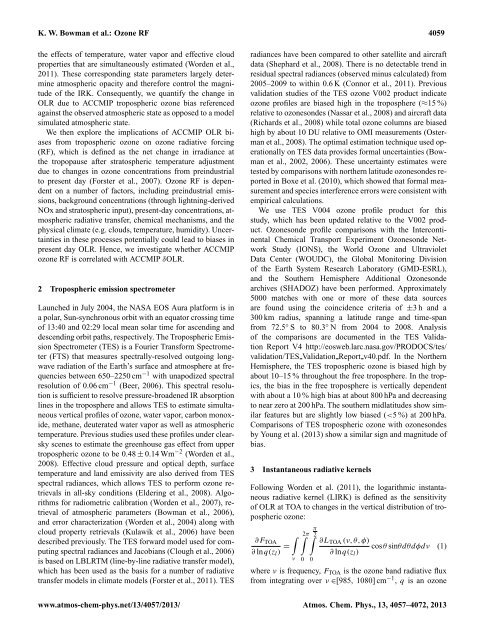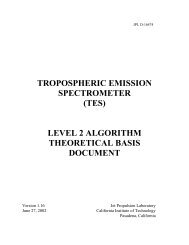Final Revised Paper - Atmospheric Chemistry and Physics
Final Revised Paper - Atmospheric Chemistry and Physics
Final Revised Paper - Atmospheric Chemistry and Physics
Create successful ePaper yourself
Turn your PDF publications into a flip-book with our unique Google optimized e-Paper software.
K. W. Bowman et al.: Ozone RF 4059<br />
the effects of temperature, water vapor <strong>and</strong> effective cloud<br />
properties that are simultaneously estimated (Worden et al.,<br />
2011). These corresponding state parameters largely determine<br />
atmospheric opacity <strong>and</strong> therefore control the magnitude<br />
of the IRK. Consequently, we quantify the change in<br />
OLR due to ACCMIP tropospheric ozone bias referenced<br />
against the observed atmospheric state as opposed to a model<br />
simulated atmospheric state.<br />
We then explore the implications of ACCMIP OLR biases<br />
from tropospheric ozone on ozone radiative forcing<br />
(RF), which is defined as the net change in irradiance at<br />
the tropopause after stratospheric temperature adjustment<br />
due to changes in ozone concentrations from preindustrial<br />
to present day (Forster et al., 2007). Ozone RF is dependent<br />
on a number of factors, including preindustrial emissions,<br />
background concentrations (through lightning-derived<br />
NOx <strong>and</strong> stratospheric input), present-day concentrations, atmospheric<br />
radiative transfer, chemical mechanisms, <strong>and</strong> the<br />
physical climate (e.g. clouds, temperature, humidity). Uncertainties<br />
in these processes potentially could lead to biases in<br />
present day OLR. Hence, we investigate whether ACCMIP<br />
ozone RF is correlated with ACCMIP δOLR.<br />
2 Tropospheric emission spectrometer<br />
Launched in July 2004, the NASA EOS Aura platform is in<br />
a polar, Sun-synchronous orbit with an equator crossing time<br />
of 13:40 <strong>and</strong> 02:29 local mean solar time for ascending <strong>and</strong><br />
descending orbit paths, respectively. The Tropospheric Emission<br />
Spectrometer (TES) is a Fourier Transform Spectrometer<br />
(FTS) that measures spectrally-resolved outgoing longwave<br />
radiation of the Earth’s surface <strong>and</strong> atmosphere at frequencies<br />
between 650–2250 cm −1 with unapodized spectral<br />
resolution of 0.06 cm −1 (Beer, 2006). This spectral resolution<br />
is sufficient to resolve pressure-broadened IR absorption<br />
lines in the troposphere <strong>and</strong> allows TES to estimate simultaneous<br />
vertical profiles of ozone, water vapor, carbon monoxide,<br />
methane, deuterated water vapor as well as atmospheric<br />
temperature. Previous studies used these profiles under clearsky<br />
scenes to estimate the greenhouse gas effect from upper<br />
tropospheric ozone to be 0.48 ± 0.14 Wm −2 (Worden et al.,<br />
2008). Effective cloud pressure <strong>and</strong> optical depth, surface<br />
temperature <strong>and</strong> l<strong>and</strong> emissivity are also derived from TES<br />
spectral radiances, which allows TES to perform ozone retrievals<br />
in all-sky conditions (Eldering et al., 2008). Algorithms<br />
for radiometric calibration (Worden et al., 2007), retrieval<br />
of atmospheric parameters (Bowman et al., 2006),<br />
<strong>and</strong> error characterization (Worden et al., 2004) along with<br />
cloud property retrievals (Kulawik et al., 2006) have been<br />
described previously. The TES forward model used for computing<br />
spectral radiances <strong>and</strong> Jacobians (Clough et al., 2006)<br />
is based on LBLRTM (line-by-line radiative transfer model),<br />
which has been used as the basis for a number of radiative<br />
transfer models in climate models (Forster et al., 2011). TES<br />
radiances have been compared to other satellite <strong>and</strong> aircraft<br />
data (Shephard et al., 2008). There is no detectable trend in<br />
residual spectral radiances (observed minus calculated) from<br />
2005–2009 to within 0.6 K (Connor et al., 2011). Previous<br />
validation studies of the TES ozone V002 product indicate<br />
ozone profiles are biased high in the troposphere (≈15 %)<br />
relative to ozonesondes (Nassar et al., 2008) <strong>and</strong> aircraft data<br />
(Richards et al., 2008) while total ozone columns are biased<br />
high by about 10 DU relative to OMI measurements (Osterman<br />
et al., 2008). The optimal estimation technique used operationally<br />
on TES data provides formal uncertainties (Bowman<br />
et al., 2002, 2006). These uncertainty estimates were<br />
tested by comparisons with northern latitude ozonesondes reported<br />
in Boxe et al. (2010), which showed that formal measurement<br />
<strong>and</strong> species interference errors were consistent with<br />
empirical calculations.<br />
We use TES V004 ozone profile product for this<br />
study, which has been updated relative to the V002 product.<br />
Ozonesonde profile comparisons with the Intercontinental<br />
Chemical Transport Experiment Ozonesonde Network<br />
Study (IONS), the World Ozone <strong>and</strong> Ultraviolet<br />
Data Center (WOUDC), the Global Monitoring Division<br />
of the Earth System Research Laboratory (GMD-ESRL),<br />
<strong>and</strong> the Southern Hemisphere Additional Ozonesonde<br />
archives (SHADOZ) have been performed. Approximately<br />
5000 matches with one or more of these data sources<br />
are found using the coincidence criteria of ±3 h <strong>and</strong> a<br />
300 km radius, spanning a latitude range <strong>and</strong> time-span<br />
from 72.5 ◦ S to 80.3 ◦ N from 2004 to 2008. Analysis<br />
of the comparisons are documented in the TES Validation<br />
Report V4 http://eosweb.larc.nasa.gov/PRODOCS/tes/<br />
validation/TES Validation Report v40.pdf. In the Northern<br />
Hemisphere, the TES tropospheric ozone is biased high by<br />
about 10–15 % throughout the free troposphere. In the tropics,<br />
the bias in the free troposphere is vertically dependent<br />
with about a 10 % high bias at about 800 hPa <strong>and</strong> decreasing<br />
to near zero at 200 hPa. The southern midlatitudes show similar<br />
features but are slightly low biased (





